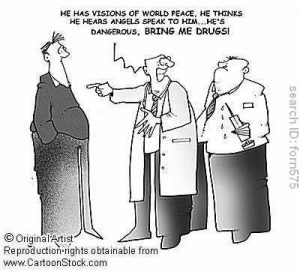This post follows on from the previous post that looked at the rising tide of compulsory psychiatric admissions in the UK in the last 2 decades, as well as at the potential role of Community Treatment Orders (compulsory care in the community) in affecting this rapid increase in compulsory admissions.

Richard Bentall, leading clinical psychologist and author of ‘Doctoring the Mind: Why psychiatric treatments fail’ (2009, London, Penguin), wrote an interesting article, entitled ‘Too much coercion in mental health services’, which raises very poignant issues and questions around coercion in mental health services in England. The article appeared in the Guardian (online) on 1st February 2013 (http://www.guardian.co.uk/commentisfree/2013/feb/01/mental-health-services-coercion).
The article is reproduced below, intercepted with my comments and thoughts (in bold).
Too much coercion in mental health services
Richard Bentall
‘Sometimes, coercion of patients may be hard to avoid, but it’s something to which mental health professionals too easily resort
The Care Quality Commission’s (CQC) annual report into the working of the Mental Health Act reveals disturbing trends in coercive practices by psychiatric services. Compared with the previous year, 2012 saw a 5% increase in involuntary detentions in hospital, and a 10% increase in the use of community treatment orders (CTOs, which require psychiatric patients currently well and living at home to comply with their treatment – usually antipsychotic medication – on penalty of being compulsorily readmitted to hospital if they do not).
These figures almost certainly understate the extent to which, in some services, coercion is routine. As the commission notes, many voluntary patients are voluntary in name only, unable to leave locked wards for fear of being sectioned if they demand to be allowed home. In the community, about a third of patients living at home are subject to informal threats or “leverage”, for example that their accommodation arrangements, benefits or right to care for their children will be affected if they do not follow medical advice.
Many mental health professionals, especially psychiatrists, see coercion as an essential tool, so it is important to understand why it should be avoided if at all possible. Respect for autonomy – the right to make choices – is, for good reason, a widely recognised principle in medical ethics. Aside from the fact that autonomy is regarded as a virtue in its own right, its denial is usually distressing. Indeed, a compulsory admission to hospital is often experienced as traumatic, sometimes leading to the same kind of post-trauma symptoms experienced by victims of assault or life-threatening events. Of course, many psychiatric patients have previously experienced physical and sexual abuse, bullying and other kinds of victimisation – that is often why they develop psychiatric problems in the first place – so coercion by services adds to a burden of adversity that is already too great to bear. It also damages relationships between patients and services, often leading to greater reluctance to seek psychiatric help during future crises’.
I was compulsorily admitted to Willow Ward at Park House, North Manchester General Hospital, for 3 months (28 January-24 April 2009) – long enough for Willow Ward to become the ultimate symbol of an oppressive, terrifying, untherapeutic and unsafe space in my psyche, a space that I came to hate and despise vehemently…the ultimate symbol of a deeply traumatising experience…
Willow Ward came to symbolise the culmination of my mental distress for me-a place where I was deprived of my liberty, where I was treated as somebody with diminished capacity and insight, where I was somebody ‘highly agitated and characterised by suicidal ideation, incontinent, occasionally subjected to physical restraint and possibly needing ECT treatment due to treatment-resistant severe psychotic depression’ (From my care records covering the period of my detention in Park House).
‘Defenders of coercion typically argue that it is a necessary evil, because patients do not know what is in their best interests. This argument, of course, assumes that patients are irrational in rejecting psychiatric care, that psychiatric treatments such as antipsychotic medication are always beneficial, and that patients compelled to receive treatment do better in the long-run.
Each of these propositions is dubious. Studies show that many patients reject drug treatment because it is experienced as ineffective and associated with side-effects (some of which are life threatening – one recent report estimated that psychotic patients, on average, have about 20 years’ reduced life expectancy, some of which is attributable to drug side effects). Recent randomised controlled trials of drug treatments – both antidepressant and antipsychotic – have shown them to be much less effective than previously thought, with many patients showing a minimal response. Finally, the existing controlled trials of CTOs show little evidence of the expected benefits in terms of reduced future hospitalisation – they are not the solution to the “revolving door” patient they were designed to be.
Ironically, these latest figures on coercion have emerged when official NHS policy is to develop services that follow a “recovery model”, which emphasises good quality relationships between patients and staff, advocates patient choice about the kind of treatment received, and which promotes an optimistic attitude in which recovery is understood holistically instead of being narrowly defined in terms of symptoms. Why, then, is practice heading in the opposite direction?’
Very early on during my detention in Willow Ward back in 2009 I sensed the complete lack of therapeutic care on the ward. Ward staff rarely (if at all) engaged meaningfully and therapeutically with the patients; staff’s interactions with the patients occurred mainly during the administration of medication and the odd bingo night! I remember staff mainly sitting in the nurses’ office and talking, eating and drinking coffee or looking at a computer when they were not administering medication.
From my case records it appears that I was very agitated, acutely distressed and constantly knocking on the nurses’ office door to tell staff that I wanted to go home or that I wanted to go to the vending machine outside the ward. Staff apparently perceived me as ‘intrusive’- it seems that my acute agitation and distress was construed as a kind of childlike ‘intrusion’, an irritation, by those very people supposedly responsible for alleviating and containing my distress. As a result, I was sent to my room (to have ‘a time out’) or, in a few instances, I was physically restrained. I now wonder whether the absence of staff’s meaningful engagement with the patients was – partly at least – due to staff’s own inability to tolerate acute mental distress and their ensuing need to defensively detach themselves from it.
‘Risk avoidance is undoubtedly a factor. A quick glance at articles about mental health in the tabloid press confirms that psychiatric patients are often viewed as dangerous (not true in the vast majority of cases) and that psychiatrists are usually blamed if their patients become violent. It is extremely difficult to predict violent behaviour, but this doesn’t prevent 20-20 hindsight when an incident occurs. Poor training is probably another factor. Since the late 1970s, psychiatry has become more medical in its orientation, leaving some psychiatrists lacking the therapeutic skills required to engage with patients effectively. With neither the time nor the training to work psychotherapeutically, drug treatment, however limited, is all they have. As Abraham Maslow remarked, “If the only tool you have is a hammer, everything looks like a nail“. In the last few years there has been intense debate within psychiatry between those who have a strictly medical view of their profession and those who advocate reform and a more patient-centred approach’.
Currently, less than adequate or poor staffing levels and the ensuing increased caseloads and time pressures for staff have been reported as an alarming feature of mental health services in England. Characteristically, 8 NHS Mental Health Units in England were recently found by the official safety watchdog to have dangerously low staffing levels (http://www.telegraph.co.uk/health/heal-our-hospitals/9797839/Seventeen-NHS-hospitals-have-dangerously-low-numbers-of-nurses.html). Poor staffing levels, increased caseloads and staff time pressures are far from conducive to the achievement of relational security in mental health wards, which can create a sense of attachment and connection for staff and patients alike. Relational security is thought to be enhanced through high staff-to-patient ratios, increased face-to-face meaningful contact between staff and patients, achieving the right ‘balance between intrusiveness and openness’ and establishing clear relational boundaries on staff’s part, as well as promoting understanding, trust, respect and therapeutic rapport between patients and staff. It is also thought to be improved by staff being appropriately trained and aware of individual patients’ histories and areas of vulnerability and risk (both prerequisites of competent and meaningful risk assessment), as well as involving patients in planning their own care (Department of Health, 2010, ‘Your guide to relational security-SEE, THINK, ACT’).
‘Of course, none of the above is to deny that, sometimes, coercion is difficult to avoid. But if coercion is a necessary evil it is still an evil and mental health services need to find ways of resorting to it less. This will require a change of culture and, perhaps, for some mental health professionals to consider alternative careers. In the long term, the solution to the problem of coercion in psychiatry is to design services that patients find helpful and actually want to use’.
Unless concerted effort is made to develop relational care and relational security in mental health wards and services instead of placing a disproportionate emphasis on physical/environmental security, we are likely to witness more compulsion, coercion and oppression in the services in question- particularly in the current socio-political and economic climate in the UK.
